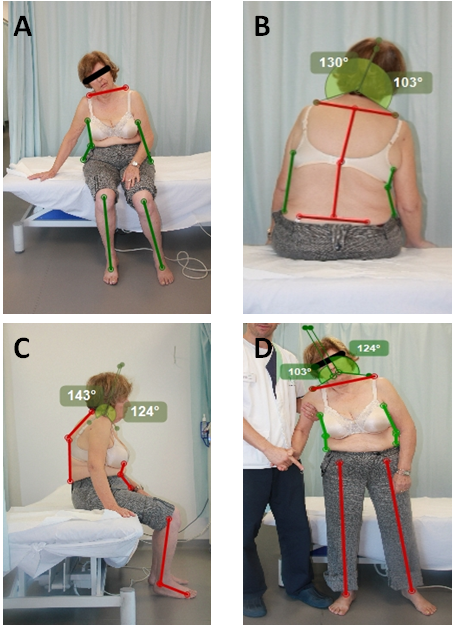The Contribution of Facilitation Techniques to Proximal Head Control as an Influencing Factor of Postural Control in a Peripheral Vestibular Injury: a Case Report
Conteúdo do artigo principal
Resumo
The Vestibular injury associated with the Peripheral Nervous System is a pathology that causes various alterations in individuals by the absence of afferent information. It mainly affects the orientation of the head and its relationship to the trunk of the body, influencing the individual’s stability by a deficit in balance and coordination. In this context a 69-year-old female subject who had undergone surgery to remove a Schwannoma from the right VIII cranial nerve or Vestibular Schwannoma, with changes in head position and postural control in seated and bipedal positions and also in gait pattern, was evaluated. After a 10-week intervention program (1-hour sessions 2 to 3 times a week) which facilitation techniques based on the Bobath Concept were used, there was a considerable improvement in the subject’s motor and functional status. The subject acquired the cervical rectification strategies necessary for better head alignment, better postural control, and a consequently greater autonomy in walking and daily activities.
Detalhes do artigo

Este trabalho está licenciado sob uma licença Creative Commons Attribution 4.0 International License.
Authors retain the copyright of their articles and grant the journal the right of first publication under the Creative Commons Attribution (CC BY) license, which allows others to share and adapt the work with proper attribution.
Referências
Bankoff ADP, Bekedorf R. Bases Neurofisiológicas do Equilíbrio Corporal. Laboratório de Avaliação Postural e Eletromiografia. 2007; 106.
Fransson PA, Kahlon B, Karlberg M, Lindberg S, Magnusson M, Siesjo P, Tjernstrom F. Prehab vs Rehab – presurgical treatment in vestibular schwannoma surgery enhances recovery of postural control better than postoperative rehabilitation: Retrospective case series. Journal of Vestibular Research 27 (2017) 313–325.
Vestibular Schwannoma (Acoustic Neuroma) and Neurofibromatosis, National Institute on Deafness and other Communication Disorders, NIH Pub N 99-580, novembro 2015.
IBITA, International Bobath Instructors Training Association; 2021 (consultado em 9 fevereiro 2021).
Brock K, Eustace C, Graham JC. The Bobath Concept in Contemporany Clinical Practise. Topics in Stroke Rehabilitation/ Jan-Fev 2009. 16 (1): 57-67.
Vestibular Rehabilitation for Peripheral Vestibular Hypofunction: An Evidence-Based Clinical Practice Guideline. American Physical Therapy Association (Neurology Section). JNPT. Abril 2016. 40: 124-154
Chen J, Fan W, Liu M. Effects of modified sit-to-stand training on balance control in hemiplegic stroke patients: A Randomized control trial. Clinical Rehabilitation. Outubro 2015; 1-10.
Ciubotaru GV, Georgescu M, Mogoanta CA, Stoian S. Vestibulary rehabilitation – Election treatment method for compensating vestibular impairment. Bucareste. Rom J Morphol Embryol 2012, 53 (3):651–656.
Gouveris HT, Mann W. Diagnosis and Therapy of Vestibular Schwa-nnoma. Expert Rev, Neurother. 2009. 9 (8): 1219-1232.
Bento RF, Neto VB, Pinna MH. Schwannona Vestibular: 825 casos, 25 anos de experiência. Int. Arch. Otorhinolaryngology. São Paulo, Brasil. 2012: v.16, 4: 466-475.
Han BI, Kim JS, Song HS. Vestibular Rehabilitation Therapy: review of Indications, Mecanisms and Key Exercices. J Clin Neurol 2011; 7:184-196
Larson S, Solan HA, Tremblay JS. Vestibular Function, Sensory Inte-gration, and Balance Anomalies: A Brief Literature Review. State College of Optometiy SUN. 2007; 3 (1): 13-17.
Cass SP, Clendaniel RA, Fife TD et al. Vestibular Rehabilitation for Peripheral Vestibular Hypofunction: An Evidence-Based Clinical Practice Guideline. American Physical Therapy Association: Neurology Section. 2016; 40: 124-154.
Clark S, Cohen LG, Duncan PW, Gage FH, Selzer ME. Textbook of Neural Repair and Rehabilitation. Nova Iorque: Cambridge University Press. 2006.
Tallitsch MT. The Nervous System: Sensory and Motor Tracts of the Spinal Cord. 7 ed. Nova Iorque: Pearson Education. 2012.
Agrawal Y, Carey JP, Minor LB, Santina CCD, Schubert MC. Disorders of Balance and Vestibular Function in US Adults. Department of Otolaryn-gology–Head and Neck, 2017.
Horak FB, Postural orientation and equilibrium: what do we need to know about neural control of balance to prevent falls? Neurological Sciences Institute of Oregon Health & Science University, Portland, OR, USA. Age and Ageing 2006; 35-S2: ii7–ii11.
Lynch-Ellerington M, Meadows L, Raine S. Bobath Concept: Theory and Clinical Practise in Neurological Rehabilitation. Oxford: Wiley-Blackwell, 2009.
Brock K, Eustace C, Graham JC. The Bobath Concept in Contemporany Clinical Practise. Topics in Stroke Rehabilitation/ Jan-Fev 2009. 16 (1): 57-67
Moreira, JCF. A evolução do conceito de Bobath: Uma revisão narrativa. Porto. Universidade Fernando Pessoa, Escola Superior de Saúde, 2012.
Michielsen M, Vaughan-Graham J, Holland A, Magri A, Suzuki M. The Bobath concept - a model to illustrate clinical practice. Disabil Rehabil. 2019 Aug;41(17):2080-2092.
Graham, JV. The Bobath (NDT) concept in adult neurological rehabilitation: What is the state of the knowledge? A scoping review. Part I: conceptual perspectives. Journal Disability and Rehabilitation. 2015. 37(20): 1793-807.
Buurke JH, Lennon S, Lyons B, Kollen BJ. The Effectiveness of the Bobath Concept in Stroke Rehabilitation What is the Evidence? American Heart Association, 2009: 89-97.
Vestibular Rehabilitation for Peripheral Vestibular Hypofunction: An Evidence-Based Clinical Practice Gui-deline. American Physical Therapy Association (Neurology Section). JNPT. 2016. 40: 124-154.
Florindo M, Pedro R. O processo de aprendizagem motora e a neuroplas-ticidade. Revista de Ciências da Saúde da Escola Superior de Saúde da Cruz Vermelha Salutis Sciencia, Lisboa. 2014; 6: 19-26.
Santina CCD, Schubert MC, Shelhamer M. Incremental angular vestibulo-ocular reflex adaptation to active head rotation. National Institute of Heath. 2008; 191(4): 435–446.
Kluding PM, Lin J, Silva LJ, Staecker H, Whitney SL. Impact of Diabetic Complications on Balance and Falls: Contribution of the Vestibular System. American Physical Therapy Association. 2016; 96 (3): 400-409.
